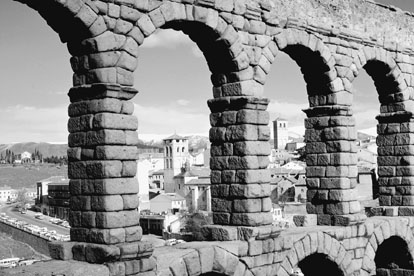 | Page 1201 |  |
of medieval archaeologists was founded in 1981, and the first national meeting on the subject was held in 1985. The traditional focus on architecture and art history has begun to be replaced by interest in urban and rural settlement patterns, in large part because of the work of A. Bazzana and P. Guichard of the Casa de Velazquez (Barcelo 1992, 245; Matesanz 1991; Rosello-Bordoy 1986, 12).

An ancient aqueduct in Segovia
(Corel)
Present archaeological activity is characterized by varied, and sometimes coordinated, lines of research (Primeras jornadas de metodología 1984; Vicent 1993; Vila 1991). These include:
- 1.
theoretical and methodological studies from culture-historical, functionalist, Marxist, and structuralist perspectives (Alcina 1991; Ruiz Rodriguez 1993; Vazquez and Risch 1991; Vicent 1994).
- 2.
studies of ecology and economy based on faunal and paleobotanical analyses as well as sedimentology in the case of older sites (Moure 1992).
- 3.
studies of settlement patterns, first from a functionalist “spatial” perspective (Arqueología 1984) and then from critical landscape perspectives based on structuralism (Criado, Rodriquez, and Viqueira 1986) or Marxism (Vicent 1991). The driving forces in this area have been specific research carried out by A. Gilman and J.B. Thornes (1985), the role of surveys as the principal means to carry out the archaeological policies of regional governments, and the incipient use of geographical information systems and remote sensing.
- 4.
social archaeological studies based primarily on mortuary studies (Chapa 1991) and settlement patterns (Arqueología 1984).
- 5.
studies of production and exchange based upon material analyses of ceramics, metals, and lithics (Bustillo and Ramos Millan 1991) and, to a lesser extent, experimental, use wear, and ethnoarchaeological research.
- 6.
underwater archaeology (Martinez 1992).
No Spanish research center has the means to carry out all those lines of investigation, and resources are unequally divided. The principal victim of this situation is archaeometry, which is faced with unequal and unfair competition for access to laboratories with research in engineering






